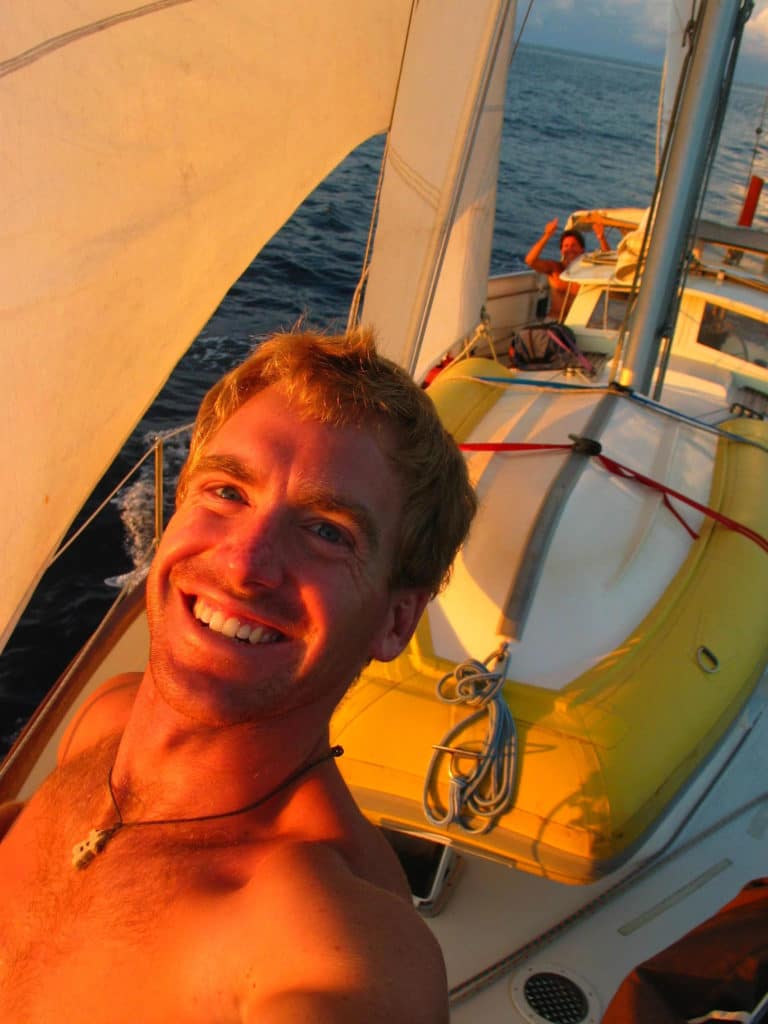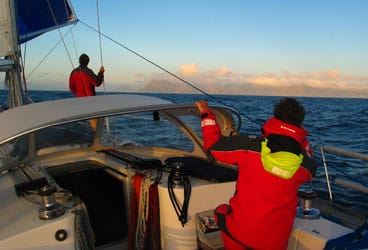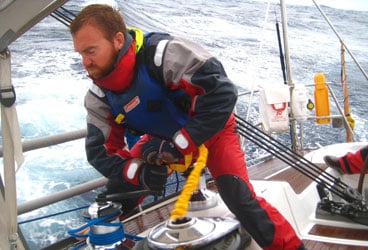
Webber2
The sky is black. The ocean is blacker. There are no lights tonight; no stars, no ships, not even the glow from a reading lamp illuminates the companionway. Somehow, the crew is finding sleep tonight despite being tossed in their bunks. It has been, after all, a tough week. Great walls of water crash all around us tonight, as they’ve done on every night this week. Again and again, they lift the boat high in the air and push it forward in powerful surges. Above me in the darkness, a double-reefed main and a poled-out scrap of jib strain under the forces of the howling wind, but it’s too dark to see either. I dare myself to look back, and when I do, I feel my heart begin to beat faster; the surreal trail of glowing bioluminescence lying in our wake appears to trail upward into the sky, illuminating a mountainous wave preparing to pounce on us. I spin forward and quickly glance at the compass and wind instruments as I prepare for the whitewater rolling toward our stern.
My hands grip the wheel tightly as the boat begins to surge forward once again. The rudder hums loudly as we accelerate down the wave face, and the roar of the water rushing out from below our transom is nearly deafening. In the corner of my eye, I can see spray leaping up from the starboard quarter in a fantastic stern wave—we’ve discovered that this happens when we’re far exceeding our theoretical hull speed. The humming below me grows higher and higher in pitch. The knotmeter races upward until it peaks at 15 knots, then slowly retreats once again. The wave finally passes, releasing the boat and leaving us to fall into a trough, where we get to await the next monster creeping out of the black night. The skies open up, and rain begins to pour down. I pull up my hood, which the wind promptly plasters to the back of my head. A quick time check reminds me that I’ve only been on watch for half an hour. I’ve got two and a half hours to go. It’s going to be a long, cold, wet night.
Throughout my watch, questions race through my head. I’ve been on many boats, and I’ll be on many more. In the pitching darkness, the boats and the sailors and the days and the nights can run together. Where are we? Which way are we sailing? How fast are we actually moving?
Right. Tonight, I’m at the helm of a Beneteau First 47.7 named Strega. We’re in the middle of the Indian Ocean. Our course is 270 degrees. We’re going directly downwind, and there’s no doubt that we’re moving very, very fast.

My adventure began in what seems to me, now, after so many nights at the helm, like ancient history. When people set out to do something big, it can be difficult sometimes to determine exactly when the first step was taken. For me, I can pinpoint the precise moment when I committed to my adventure: when I wove a Turk’s head knot around my wrist. It was just like the one my father would give me, during our summer sailing trips when I was a young boy, right after we sailed away from the dock. After this ceremonial moment, the rest of my adventure seemed to fall into place, piece by piece: the airline ticket to Panama, dipping my toes in the Caribbean Sea, the symbolic hoisting of my thumb to find a ride. My plan was to circumnavigate the planet by sailboat in a slightly unorthodox way: I would do it by hitchhiking (Click here for more of Clive’s tips for hitchhikers).
All right, perhaps a dark and stormy night in the Indian Ocean isn’t the ideal time to reminisce, but sailors know that memories tend to keep our minds occupied at night during long passages. I chuckle when I look back on my naïve and slightly disorganized arrival in Panama 10 months before, when I stepped off the plane into sweltering tropical heat while already decked out—and sweating profusely—in my foul-weather gear. Since then, I’ve sailed on eight different sailboats and met some of the most interesting characters on the planet, each with his or her own unique reasons for sailing the high seas. Not every situation was ideal, nor was everyone’s personality compatible with my own, but all told, not one of my experiences could be defined as negative. Most important, as much as the sailors varied from one another, every single one of them has had one thing in common: For one reason or another, in order to fulfill their dreams, they couldn’t do it on their own. I was no different.
Strega has been my home since Cairns, Australia. Her crew is participating in the World Cruising Club’s World ARC round-the-world rally. The rally has attracted other high-seas hitchhikers who, like myself, have long dreamed of sailing across oceans—or at least a part of one. When I made my way across the Pacific, sailors on the boats I caught rides with continually came and went. With every island that appeared on the horizon, so, too, did new hitchhikers, ready and willing to fill in the gaps left by those disembarking. However, crossing the Indian Ocean on Strega has been different. Not only are there fewer boats, but fewer hitchhikers as well. At this point in the rally, a definite symbiotic relationship has developed during the last few passages between the owners of the sailboats and the crews. We rely very much on each other. It may appear that we need one other merely to share the mundane responsibilities of cooking duties and night watches, but in fact, the connections go much deeper and reach to the very heart of the big picture: We’re helping each other to fulfill our dreams.
There’s a kind of diametrical contrast at play when a group of strangers go to sea together. We all work as a team to move the boat and the adventure forward, yet as the days wear on, our identities as individuals—rather than as teammates—often intensify. We’re here in the middle of the ocean out of our own doing, each with our own personal ambitions that allow us to push onward. The strength of those ambitions can often determine how long we’ll function as team members before retreating into personal cocoons once the fatigue and cabin fever of a long passage set in. After hitchhiking for so many months at sea, I’ve witnessed the entire spectrum of ambition, from a captain terminally ill with cancer and determined to live it up to young people disenchanted with everyday life to people who’ve accomplished so much in this world that sailing around it seemed, somewhat matter-of-factly, like the next logical step. My own ambitions had long brewed, since those summer sailing holidays in my youth that I once shared with my father. Over the years, we’d both secretly dreamed of seeing exotic islands on the horizon and sailing night after night beneath star-filled skies. My ambition, when I set out on this journey, was to accomplish that dream for both of us. However, when I reached the halfway mark of my circumnavigation, the farthest point from home, that ambition was dealt a blow. Soon after sailing westward from Australia on Strega, I received news that my father had died.
Now as I sail across the Indian Ocean, each night I blink away the tears in my eyes and remind myself that completing this difficult ocean passage would make my father very proud.

My watch tonight draws to a close as the sky begins to lighten. Overnight, we’ve passed the midway point of our 2,000-mile passage between Australia’s Cocos, or Keeling, Islands, at 12 degrees south, 97 degrees east, and the island of Rodrigues, at 19 degrees south, 63 degrees east. Strega has been averaging almost exactly 200 miles a day as the consistent trade winds push us across the ocean in the company of waves, seabirds, and dolphins. A lucky crewmember takes over for the beloved sunrise watch while I set about turning off the navigation lights and putting on the kettle. The sun warms our backs and begins its climb into the sky. Our world is once again filled with diamondlike sparkles on the brilliant blue water that surrounds us on all points of the compass. Holding my mug of coffee, I look back off the stern to admire the spray and foam from our wake. Watching it trail far off into the distance behind us, I imagine that my journey is painting a thin white line across a big blue canvas.
The Indian Ocean has reminded me that a sea voyage is as much art as it is adventure. The white line we leave behind is a perfect expression of freedom and movement on a canvas thousands of miles wide.

In the evening, I once again take my place behind the helm. The canvas explodes all around me with the vivid golden colors of sunset before turning dark once again. Blue becomes black, and our white line is replaced by iridescent green from the microorganisms that light up in response to our passing. Despite the persistent squalls and huge waves, one can easily find peace out here; the middle of an ocean is a world in itself, far from our egocentric human civilization. This world doesn’t concern itself with our worries and fears. As sailors, we possess the unique ability to catch a glimpse of this expanse and see it blink back at us. Our stern waves exist for an insignificant moment in time on the ocean’s surface; life continues on here as though we’d never passed by.
Tonight, we continue onward across the ocean, and I again contemplate how the bright line trailing away from our transom represents the art of sailing. But the glimmer from a comb jelly in the dark water below reminds me that this canvas will long outlive the painter.
Clive Webber completed his 25,000-mile circumnavigation in Panama’s San Blas islands. During his 16-month journey, he hitched rides on at least 11 sailboats; they ranged in length from 34 to 58 feet. For more stories of his adventure as well as additional tips on how to hitch rides on sailboats crossing the world’s oceans, visit his website (www.stinkyfeetproject.org).
Resources:
How to Find a Ride
Crewing websites: Scouring the web is a moderately effective way to find a ride. Note, however, that many skippers are looking for paying crew to finance their own way. Also, many male skippers are seeking female companionship.
Posting an ad: All yacht clubs, marinas, and chandleries have bulletin boards and will gladly put up your notice for free. I’ve never found a ride from posting an ad, but it costs so little time and effort that it would be silly not to cover this base.
Walking the dock: The usual method for finding a ride is to visit every single yacht in a harbor with a smile on your face. Don’t be shy about making conversation; people will open up to you and share the contact information of friends they’ve met in the area who may need crew.
Cruising the anchorage: My secret weapon! Borrow a dinghy and visit the boats in the anchorage. It can be time-consuming, but this savvy, face-to-face method is usually very effective. Boats in the anchorage are generally transient vessels, and very few of them get visited by other hitchhikers, thus increasing your chances of success.
Get broadcasted: Ask local sailors if there’s a VHF cruisers network that regularly broadcasts in the morning. Identify the network organizer and make the connection. This, too, is a hitchhiker-savvy way to make a connection, and it beats rowing the borrowed dinghy all over the anchorage.
Find the local hangout: After a long day of scouring the docks, set up shop at the cruisers bar for happy hour. Now the yachties will be approaching you!
The Right Stuff for the Complete Ocean Hitchhiker
• Alarm clock
• Anti-seasickness tablets
• Foul-weather gear and sailing gloves
• A light sleeping bag
• Snorkel gear
• A personal logbook in which to record mileage and hours at sea
• Music, etc: CDs with MP3s or iPod
• A mobile phone with international SIM-card capabilities
• Large-capacity USB flash drive
• 12-volt chargers for all electronics
• An LED headlamp
• Old novels for book exchanges
• Food magazines with many recipes
• A lifejacket and a harness/tether (although many boats provide these)
Location Is Everything
If you’re an aspiring hitchhiker on the high seas, you’ll learn very quickly that catching a ride is all about location.
Be in the right spot at the right time. To take advantage of the most favorable weather, most skippers follow well-trod routes around the world at particular times of the year. Before picking your hitchhiking route, become familiar with ocean routes, storm and cruising seasons, trade-wind patterns, and popular ports of call.
Finding your first ride is usually the toughest task. Because yacht owners actively seek crew when a long passage lies ahead, identify the ports that are popular jumping-off points before established long ocean passages.
If you’re a socialite, consider following yacht-race circuits; these usually occur in popular cruising grounds and offer the bonus of good nightlife. Spectator boats and race participants alike often take on an extra hand just for the fun of it.







